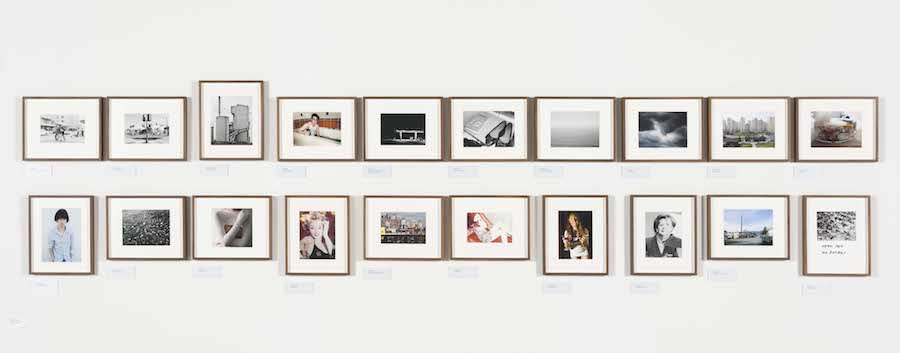
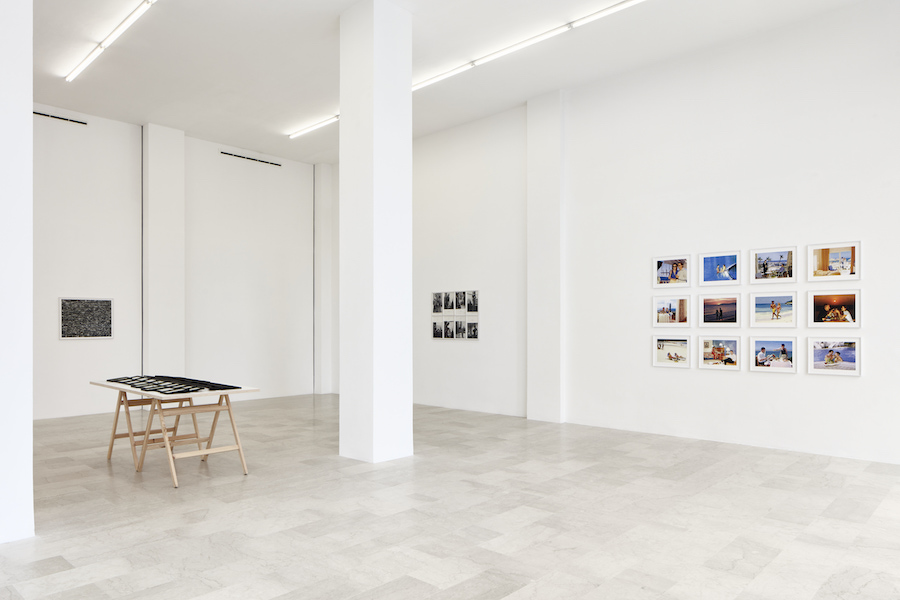
English text below —
A prescindere dal processo interpretativo riferito alle immagini e ai soggetti presenti nelle photo trouvée e di tutte le letture che ne possono conseguire, la poetica del riuso di Joachim Schmid è anche soprattutto una scelta etica, un rimando e un invito a una sorta di ritrazione rispetto all’incontinente flusso di scatti che ogni giorno viene prodotto e messo in circolo nella società dominata dalla telefonia fotografica e dalle promesse di visibilità dei social. Nella mostra in corso alla Galleria P420 (dal 26 gennaio al 6 marzo 2021), l’artista tedesco prende in esame il “fattore caso”, che è uno degli aspetti più interessanti ed enigmatici quando ci si aggira nei mercatini delle pulci e si trova qualcosa. Poi l’incontro casuale mette in azione collegamenti di senso e riletture, innesca altre dinamiche, derive e direzioni. Le photo trouvée vengono riconsiderate e dotate di un’aura “altra”, sebbene siano contenute in un dispositivo che rimette in questione le nozioni di opera, autore, collezione.
Per rimettere in azione immagini disperse o mandate al macero è necessario predisporre dispositivi atti a condurre memoria fotografica. L’operazione di Schmid induce a estendere le possibilità dello sguardo, a uscire dall’esistenza unicamente individuale, per immaginare altri recuperi ed estensioni concettuali. In questa apertura brulica la copiosa materia dell’anonimia: individui (perlopiù non più vivi o dimenticati), oggetti, luoghi, date, appunti, sentimenti, emozioni, cose non dette. È interessante osservare in questa esperienza soprattutto il “soggetto massa”, l’insieme di presenze non individuabili che accomuna tutti, qualcosa che funge anche da specchio in cui cadere per riconoscersi attraverso personali proiezioni. Schmid innesca nella sua macchina combinatoria i dispositivi di ripetizione di cose precedenti, sviluppando continuamente una capacità di riproposizione, aggregazione e sviluppo. Mi viene in mente, per fare un esempio pratico, l’utilizzo di Melville rispetto a qualcosa che era già presente nella Bibbia o nella tragedia greca, per far risuonare nella trama di Moby Dick qualcosa di più espanso. Attraverso le fotografie anodine l’artista tedesco rende vivi il senso della fragilità, le apparenze inattese, lo sguardo che si sorprende a trovare delle evocazioni familiari, la preziosità intima dei giorni feriali, le reminiscenze sgrammaticate della nostalgia, i vacillamenti, le indecisioni, gli errori, le sfocature, insomma una serie di possibilità che raramente è stata presa in considerazione dalla storia dell’arte, dal cinema e dalla fotografia d’autore.
Come è stato sottolineato dalla critica in più riprese, la scelta di non utilizzare la macchina fotografica e sospendere la produzione di altre immagini ha spostato l’azione verso altre declinazioni del fare, ovvero verso la ricerca, raccolta e riutilizzo di fotografie già esistenti e scattate da altri, trovate nei mercatini delle pulci, negli archivi, o immagini scaricate dalla rete. In questo gesto è racchiusa anche una metafora, che sarebbe piaciuta a Bartleby – ovvero all’apostolo dell’autonegazione – e a chi prende le distanze dal “troppo” e dal “di troppo”. Schmid è vicino alla sensibilità dell’antieroe di Melville, al rifiuto della sovrabbondanza futile. Si attiene al motto di Montaigne: “Je m’abstiens” (Io mi astengo). Rifiuta i compromessi. La sua scelta di non fotografare apre a una serie di negazioni o a qualcosa che va costruendosi in negativo (mi riferisco a una modalità che è vicina alla teologia al negativo, cioè a chi desidera evocare il divino attraverso parole e frasi costruite per sottolineare cosa non sia Dio). Mette contemporaneamente in azione due movimenti, da una parte quello in levare, ovvero la scelta di non fare più fotografie e di non contribuire alla sovraproduzione di scatti fotografici, e dall’altra invece quello che raccoglie per aggiunta continua nuove immagini trovate. Non siamo di fronte a una contraddizione, bensì a un cortocircuito ben congegnato. Da qui si aprono poi effetti collaterali, diagnosi anche simboliche, innumerevoli storie interne, metalinguaggi, ipertesti concettuali, immagini latenti, continue domande, e altro ancora. Cosa risuona nei dispositivi di Schmid, nelle sue raccolte di fotografie vernacolari e di immagini prelevate da internet? Cosa si ramifica dal suo pessimismo privato? Cosa prende corpo dall’arrangiare fonti inomogenee (di fotografie, figurine, manifesti, cartoline, etc.) che provengono da innumerevoli vite altre?



I lavori di Schmid sono espandibili verso sempre nuove narrazioni, tra realismo vernacolare e fiction. Che racconti, riletture o interpretazioni prendono vita da fotografie che provengono da album di famiglia o da immagini caricate da milioni di persone su Instagram o su Flickr? Nelle fotografie salvate dal macero o dall’oblio, soprattutto quelle ricomposte dopo essere state strappate a pezzetti dal precedente proprietario, c’è al contempo qualcosa che sa di cortocircuito, come qualcosa che passa da un momento all’altro dalla commedia alla tragedia, o viceversa. Schmid ci fa vivere in modo ironico la natura tragica delle sue photo trouvée, mostra gli imprevisti, la sospensione di ogni giudizio, la suspence concettuale.
Nella prima sala della galleria sono esposti lavori di diversi periodi: Zur Theorie der Fotografie (1986), Statics (1995-1996), Meetings (2003-2007), The Artist’s Model (2016), R.Flick Collection (2017), Il Mare (2019). Nella seconda sala è allestita la grande installazione di Bilder von der Strasse (1982-2012) e la videoproiezione delle 1000 immagini trovate nell’arco di trent’anni, che rivelano una serie di tentativi utili nell’esercizio dell’osservazione e del decifrare.
I modi di recepire le immagini sono legati agli schemi interpretativi che in un determinato momento della storia guidano le reazioni degli osservatori. È necessario avere ben presente che a loro volta questi schemi interpretativi e i canoni che guidano la ricezione hanno una ricaduta anche su chi realizza un’opera, ovvero che questi dati influenzano i modi con cui l’artista costruisce le sue immagini. Dimensione linguistica e dimensione visiva convivono sia all’interno sia oltre ogni categoria culturale. La memoria iconologica e l’arte della memoria si sono sempre rapportate con la storia della lettura e della scrittura, con l’oralità e con le maniere di assimilare dei testi, entro una res che attraversa i tempi e le generazioni. Il processo mentale che lascia anche tracce nel corpo, le tecniche di memoria della retorica classica, la creazione di mappe di luoghi, la collocazione interiore dei testi letti o sentiti entrano in gioco nel rapporto con la fruizione delle immagini? Il materiale letterario e il corpus delle immagini registrati nella memoria sono i mezzi per muovere nuove associazioni di senso, altri pensieri e intuizioni. Ci troviamo di fronte a un’opera aperta, che prevede un continuo mutamento in rapporto a chi entra nel gioco interpretativo. È chiaro che in un rapporto del genere è determinante la ricezione dello spettatore, del lettore, del fruitore attivo. Joachim Schmid è riuscito a scardinare le false certezze di chi nell’atto d’interpretazione di un’opera d’arte ha sempre seguito tre regole basilari: a) tutti i pezzi del puzzle, ovvero tutte le photo trouvée con gli elementi iconografici rilevanti, devono andare a posto e non lasciare vuoti nella visione unitaria; b) i pezzi devono comporre un disegno coerente; c) a parità di condizioni, l’interpretazione che implica meno ipotesi dev’essere considerata, in generale, la più probabile. Quindi, il gioco allegorico richiede molto tempo e fatica per la pratica della decifrazione, ma ha la capacità di imprimersi profondamente nella memoria e di generare piacere quando si riesce nell’impresa di creare illuminanti collegamenti di senso. Come un Mercurio che agisce in un tempo e in una civiltà assuefatti dalla sempre crescente proliferazione delle immagini, Schmid trova e rimette in azione messaggi visivi da consegnare a chi preferisce fare un passo indietro prima di spiccare un lungo balzo in avanti.
Le opere di Joachim Schmid sono state esposte in musei di tutto il mondo e fanno parte di molte importanti collezioni internazionali. Nel 2007, in occasione della sua prima retrospettiva al Frances Young Tang Teaching Museum and Art Gallery a Saratoga Springs (NY), Photoworks & Steidl ha pubblicato un’ampia monografia intitolata Joachim Schmid Photoworks 1982–2007. Oltre ad aver pubblicato più di 100 libri d’artista, alla fine del 2009 Schmid ha fondato la ABC Artists’ Books Cooperative, un collettivo di artisti che autopubblicano le proprie opere utilizzando il metodo del print-on-demand, ossia la stampa su richiesta.


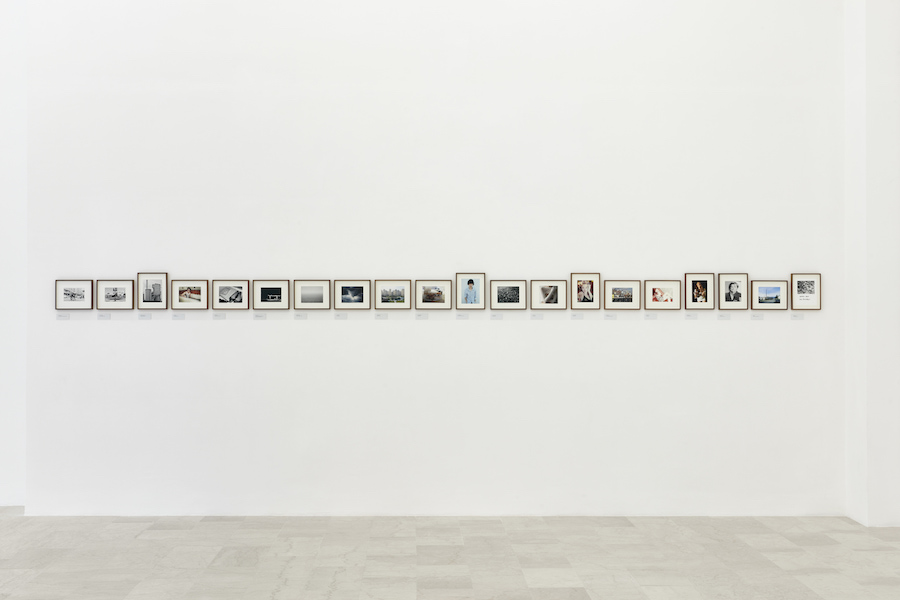
Joachim Schmid. Photoworks | Gallery P420, Bologna
Regardless of the interpretative process referred to the images and subjects present in the photo trouvée and of all the readings that may follow, Joachim Schmid‘s poetics of reuse is also above all an ethical choice, a reference and an invitation to a sort of retraction with respect to the incontinent flow of shots that are produced and circulated every day in the society dominated by photographic telephony and the promises of visibility of social networks. In the current exhibition at the P420 Gallery (from January 26th to March 6th, 2021), the German artist examines the “chance factor”, which is one of the most interesting and enigmatic aspects when wandering around flea markets and finding something. Then the chance encounter sets into action connections of meaning and reinterpretations, triggers other dynamics, drifts and directions. The photo trouvées are reconsidered and endowed with an “other” aura, even though they are contained in a device that calls into question the notions of work, author and collection.
In order to put back into action images that have been dispersed or sent to the rubble, it is necessary to set up devices capable of conducting photographic memory. Schmid’s operation induces us to extend the possibilities of the gaze, to leave behind a uniquely individual existence in order to imagine other recoveries and conceptual extensions. In this opening, the copious material of anonymity swarms: individuals (mostly no longer alive or forgotten), objects, places, dates, notes, feelings, emotions, unspoken things. It is interesting to observe in this experience above all the “mass subject”, the set of unidentifiable presences that unites everyone, something that also acts as a mirror in which to fall in order to recognize oneself through personal projections. Schmid triggers in his combinatory machine the devices of repetition of previous things, continuously developing a capacity for reproposition, aggregation and development. I am reminded, to give a practical example, of Melville’s use of something that was already present in the Bible or Greek tragedy to make something more expansive resonate in the plot of Moby Dick. Through his anodyne photographs, the German artist brings to life the sense of fragility, the unexpected appearances, the gaze that is surprised to find familiar evocations, the intimate preciousness of weekdays, the ungrammatical reminiscences of nostalgia, the vacillations, indecisions, mistakes, blurs, in short, a range of possibilities that has rarely been considered by art history, cinema, and art photography.
As has been underlined by critics on several occasions, the choice of not using the camera and suspending the production of other images has shifted the action towards other declensions of making, that is, towards the research, collection and reuse of already existing photographs taken by others, found in flea markets, in archives, or images downloaded from the web. This gesture also contains a metaphor that would have appealed to Bartleby – the apostle of self-denial – and to those who distance themselves from “too much” and from “too much”. Schmid is close to the sensibility of Melville’s anti-hero, to the rejection of futile overabundance. He adheres to Montaigne’s motto: “Je m’abstiens” (I abstain). He refuses to compromise. His choice not to photograph opens up a series of negations or something that is constructed in the negative (I am referring to a mode that is close to negative theology, that is, to those who wish to evoke the divine through words and phrases constructed to emphasize what God is not). It puts two movements into action at the same time, on the one hand the one in levare, that is the choice not to take any more photographs and not to contribute to the overproduction of photographic shots, and on the other hand the one that collects by continuous addition new found images. We are not faced with a contradiction, but rather with a well-conceived short-circuit. This opens up collateral effects, symbolic diagnoses, countless internal stories, metalanguage, conceptual hypertexts, latent images, continuous questions, and more. What resonates in Schmid’s devices, in his collections of vernacular photographs and images taken from the internet? What branches out from his private pessimism? What takes shape from arranging inhomogeneous sources (of photographs, figurines, posters, postcards, etc.) that come from countless other lives?
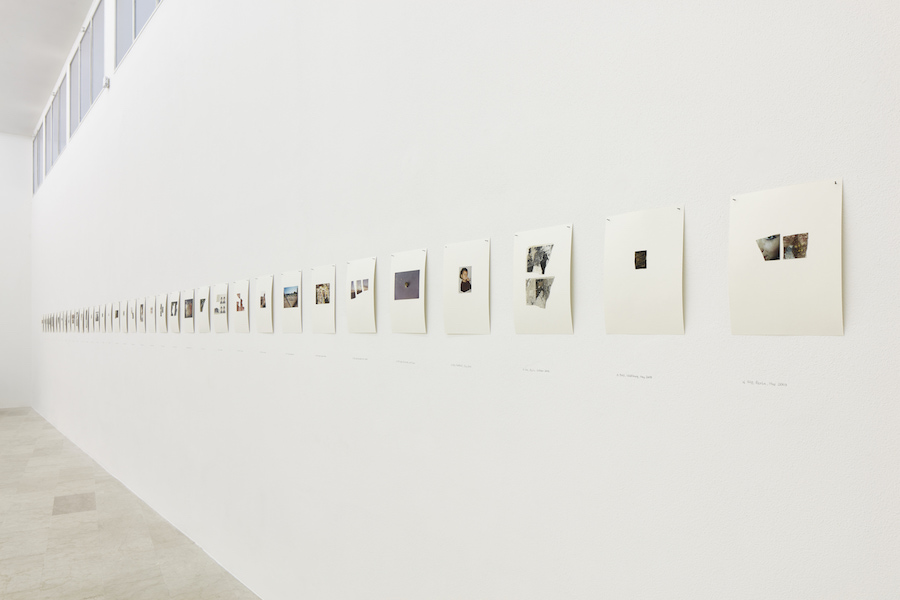
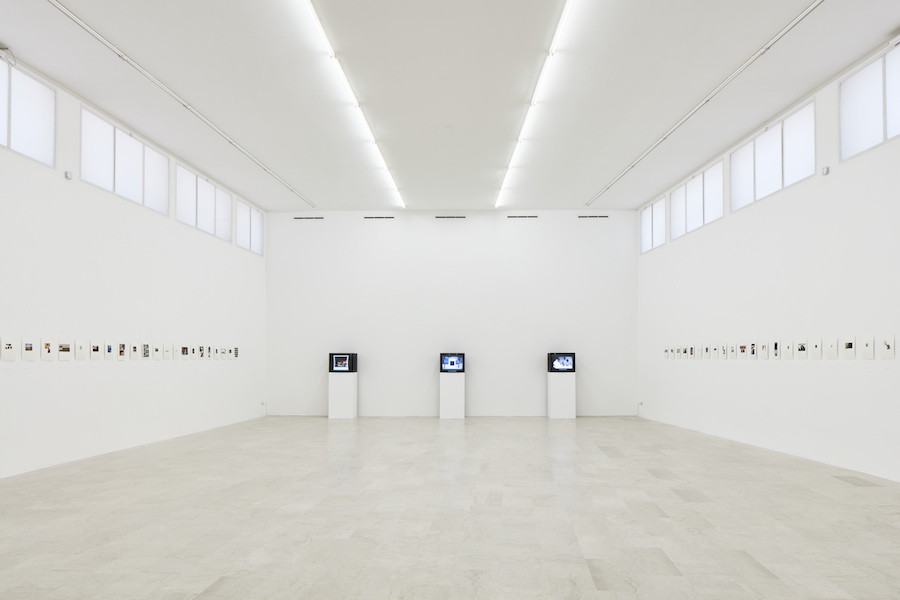
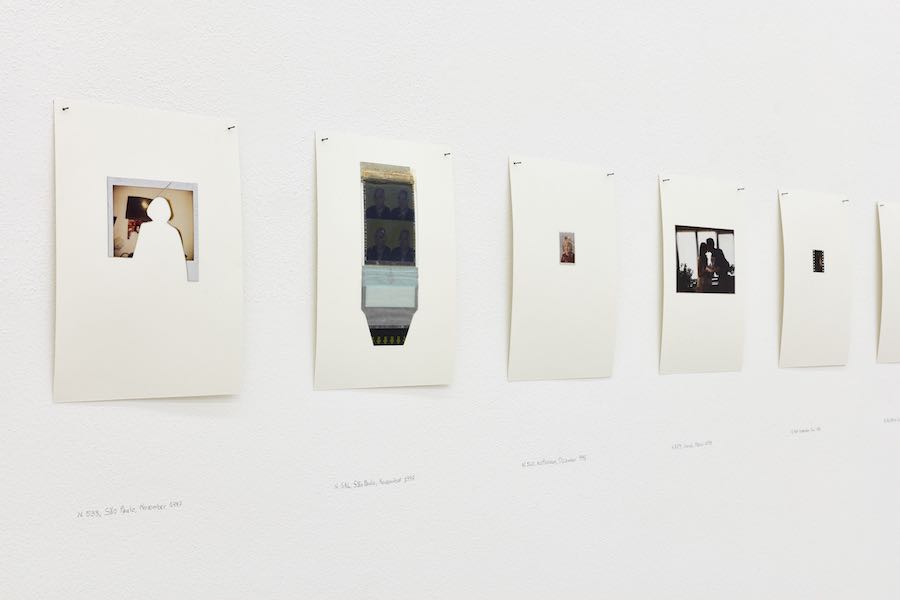
Schmid’s works are expandable to ever new narratives, between vernacular realism and fiction. What narratives, reinterpretations or interpretations come to life from photographs that come from family albums or from images uploaded by millions on Instagram or Flickr? In the photographs rescued from the scrap heap or from oblivion, especially those reassembled after having been torn to pieces by the previous owner, there is at the same time something that smacks of a short circuit, like something that goes from one moment to the next from comedy to tragedy, or vice versa. Schmid makes us experience the tragic nature of his photo trouvées in an ironic way, he shows the unexpected, the suspension of all judgment, the conceptual suspense.
The first room of the gallery displays works from different periods: Zur Theorie der Fotografie (1986), Statics (1995-1996), Meetings (2003-2007), The Artist’s Model (2016), R.Flick Collection (2017), Il Mare (2019). In the second room is the large installation of Bilder von der Strasse (1982-2012) and the video projection of the 1000 images found over thirty years, revealing a series of useful attempts in the exercise of observation and deciphering.
The ways in which images are received are linked to the interpretative schemes that, at a given moment in history, guide the reactions of observers. It is necessary to keep in mind that these interpretative schemes and the canons that guide reception also have an effect on those who create a work, that is, these data influence the ways in which the artist constructs his images. Linguistic and visual dimensions coexist both within and beyond each cultural category. Iconological memory and the art of memory have always been related to the history of reading and writing, to orality and to the ways of assimilating texts, within a res that crosses times and generations. Does the mental process that also leaves traces in the body, the memory techniques of classical rhetoric, the creation of maps of places, the inner location of texts read or felt come into play in the relationship with the fruition of images? The literary material and the corpus of images recorded in memory are the means to move new associations of meaning, other thoughts and intuitions. We find ourselves in front of an open work, which foresees a continuous change in relation to those who enter into the game of interpretation. It is clear that in such a relationship the reception of the spectator, of the reader, of the active user is decisive. Joachim Schmid has succeeded in unhinging the false certainties of those who, in the act of interpreting a work of art, have always followed three basic rules: a) all the pieces of the puzzle, that is, all the photo trouvées with the relevant iconographic elements, must fit together and leave no gaps in the unitary vision; b) the pieces must compose a coherent design; c) all things being equal, the interpretation that implies the fewest hypotheses must generally be considered the most probable. Thus, the allegorical game requires a great deal of time and effort for the practice of deciphering, but it has the ability to imprint itself deeply in the memory and to generate pleasure when one succeeds in the enterprise of creating illuminating connections of meaning. Like a Mercury acting in a time and civilization addicted to the ever-increasing proliferation of images, Schmid finds and puts back into action visual messages to be delivered to those who prefer to take a step back before taking a long leap forward.











